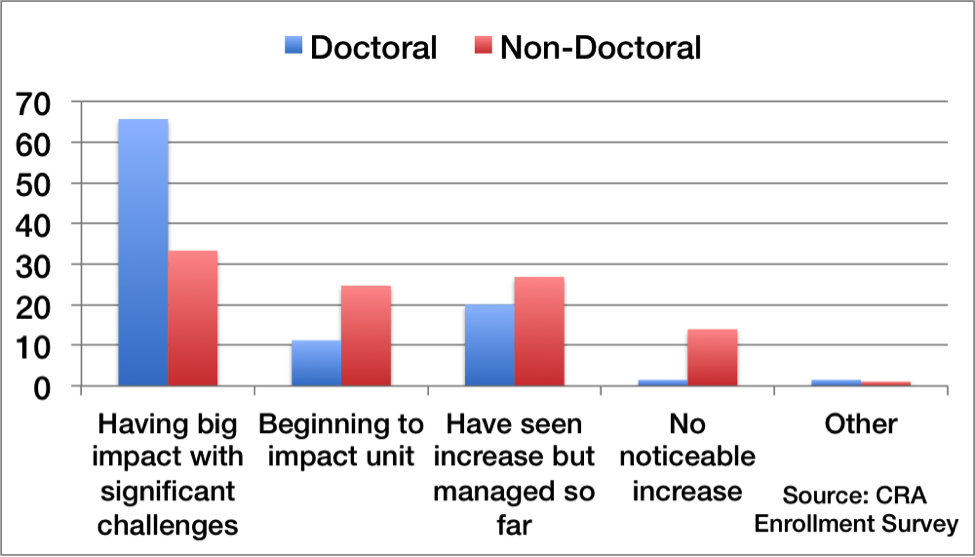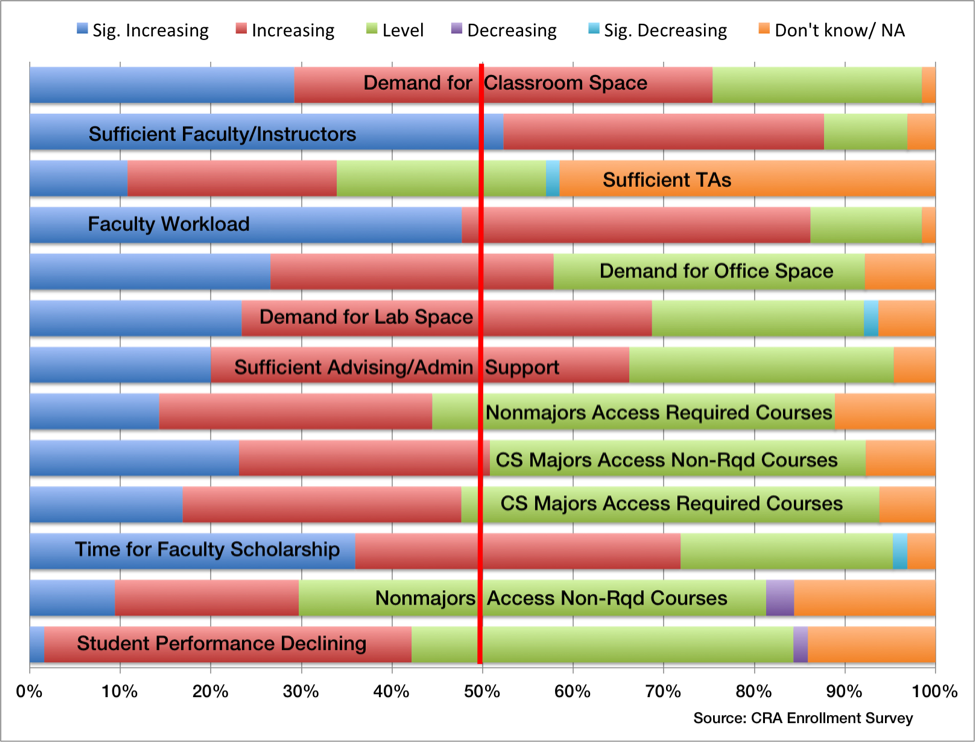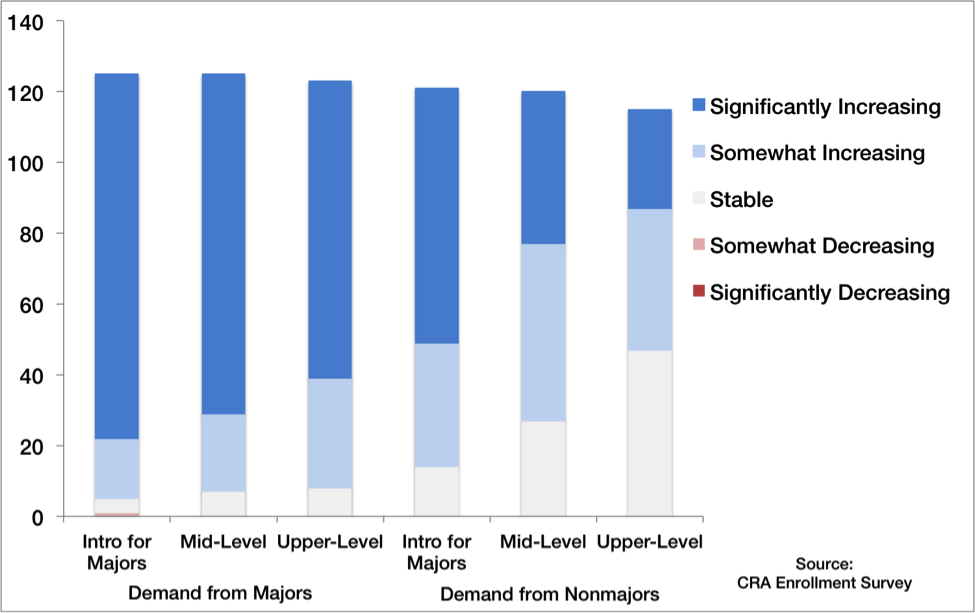E. The Challenges of the Enrollment Surge for the Unit
The data collected from the CRA Enrollment Survey shows that the impact on computer science units[1] from increasing enrollments is significant[2] (Figure E.1). For example, 66% of the 134 responding doctoral-granting units reported that the enrollment growth is having a big impact (i.e., causing significant challenges) on their unit, while almost 60% of the 93 responding non-doctoral granting units reported that the enrollment growth is beginning to have an impact or already is having a significant impact.

Figure E.1: Percentage of doctoral- and non-doctoral granting units experiencing a given level of impact.
Comprehensive data from the Integrated Postsecondary Education Data System (IPEDS) on degree completions can further our understanding of the situation at non-doctoral granting units relative to their doctoral counterparts. In the IPEDS data, we see a significant growth in computer science degree completions at doctoral-granting units[3] [G. IPEDS Data]. In other words, the IPEDS completions data from the broader set of 313 doctoral-granting units is consistent with the substantial growth reported by the 134 doctoral-granting units responding to the CRA Enrollment Survey. At the 1,185 non-doctoral granting units, the number of IPEDS computer science degree completions is increasing, but this is occurring more slowly than at the doctoral-granting units. Since the number of degree completions is increasing more slowly, it makes sense that non-doctoral granting units are less likely than the doctoral-granting units to report they are experiencing a significant impact from increasing enrollments (33% vs. 66%).
The CRA Enrollment Survey requested units to report problems and concerns related to increasing enrollments. Figures E.2(a) and E.2(b) provide the responses from doctoral- and non-doctoral-granting units, respectively. Classroom space shortages, insufficient numbers of faculty/instructors, and increased faculty workloads were among the top concerns at both doctoral- and non-doctoral granting units. Insufficient numbers of TAs was also a top concern at doctoral-granting units.

(a) Doctoral-Granting Units

(b) Non-Doctoral Granting Units
Figure E.2: Percentage of units stating whether a given problem or concern exists at their unit due to increasing enrollment.
In fact, more than 50% of the respondents from doctoral-granting units identified six significantly increasing problems or concerns due to growing enrollments: classroom space, faculty/instructors, TAs, faculty workload, office space, and lab space. The respondents from non-doctoral granting units also identified several problems or concerns due to increasing enrollments. However, besides insufficient numbers of faculty/instructors, no other problem or concern was rated as significantly increasing from more than 50% of the respondents. More than 50% of the respondents from non-doctoral granting units did identify eight problems or concerns at the significantly increasing or increasing level: classroom space, faculty/instructors, faculty workload, office space, lab space, advising and administrative support, time for faculty to do research, and non-majors getting into non-required courses. If we consider responses at the significantly increasing or increasing level, then all but one of the listed problems or concerns were rated above 50% by respondents from doctoral-granting units. Despite increasing enrollments, approximately 45% of doctoral- and 40% of non-doctoral granting units perceive that student performance is level. However, approximately 35% of doctoral- and 40% of non-doctoral-granting units perceive that student performance is declining. Many of the other 20% are unsure, which suggests these units should more closely monitor the impact of increasing enrollments on student performance.
In regard to other student impacts, the majority of institutions reported that student retention was level or increasing overall. Similarly, most doctoral- and non-doctoral granting units reported that the ratio of women and other underrepresented groups entering the CS degree program was level or increasing. Diversity is discussed in more detail in [D. Impact on Diversity].

Figure E.3: Number of doctoral-granting units reporting levels of increased demand from majors and nonmajors by course level.
Figure E.3 shows doctoral-granting respondents’ qualitative responses about where they believe the increasing demand exists. A large number of units believe there are significant increases in demand for computer science major courses by computer science majors. This perception data is supported by the phenomenal growth of computer science majors [B. Growth of CS Majors]. While respondents believe the increase is most significant in the introductory courses (i.e., 82% of respondents stated a significant increase in demand from majors exists for intro courses), respondents believe there is also a significant increase in demand for mid-level and upper-level courses (e.g., 68% of respondents stated a significant increase in demand exists for upper-level courses).
Many doctoral-granting respondents stated there is a demand from nonmajors for computer science major courses, but they believe the demand from nonmajors is less of an issue than the demand from majors. For example, 41% of units reported a stable demand from nonmajors for upper-level courses. Any increase in nonmajor demand for mid-level and upper-level CS courses can be partly explained by the demand of these courses from CS minors (who are considered nonmajors by many units). While not shown in a figure, doctoral-granting units report that the number of students seeking minors is stable for only 21% of the units, somewhat increasing for 50% of the units, and significantly increasing for 29% of the units. The impact on units from nonmajors is discussed in more detail in [C. Nonmajors Impact]. Lastly, Figure E.3 shows that only one unit reported a perceived decrease in demand for any computer science major course.
Summary
Classroom space shortages, insufficient numbers of faculty and instructors to teach courses, and increased faculty workloads are among the top problems and concerns at doctoral-granting and non-doctoral granting units. On the positive side, the CRA Enrollment Survey found that approximately 88% of both doctoral- and non-doctoral granting respondents believe that student retention is level or increasing overall. Also, approximately 40% of respondents believe student performance has not been adversely affected so far. On the other hand, more than one-third of the units reported concerns that student performance is declining. Many units stated that students are facing increased challenges to enroll in required and non-required CS classes. Units also report that it is increasingly difficult to advise all of their students and provide the needed administrative support.
Many units are clearly struggling to cope with their current enrollments in computer science courses. Larger faculty workloads resulting from increased enrollments may decrease faculty retention, which will exacerbate the problems that units have in covering their courses. Current pressures on computer science units are extremely difficult to manage and will also intensify if enrollments continue to grow. Institutional administrators need to work with computer science units to find sustainable approaches to meet the student demand, accounting for important factors such as (1) lack of space for classes and units, (2) academic support required, (3) the limited pool of qualified teaching faculty, (4) the goals and needs of nonmajors taking CS classes, (5) the effect of class size on the course experience, and (6) the desired retention of both students and faculty.
[1] We use the term “academic unit” or “unit” to denote the administrative division responsible for the CS bachelor’s program. Often, but not always, this is an academic department.
[2] The use of the term “significant” in this section does not refer to statistical significance. Instead it reflects the qualitative perception of the units who responded to survey questions asking about “significant” demands and challenges.
[3] IPEDS doctoral-granting units are institutions that grant at least 20 research/scholarship doctorates in any field (not including professional practice doctoral-level degrees such as JD and MD), following the Carnegie Classification of Institutions of Higher Education. Taulbee and NDC survey data define doctoral- and non-doctoral granting units by whether the unit grants doctorates in computing.

